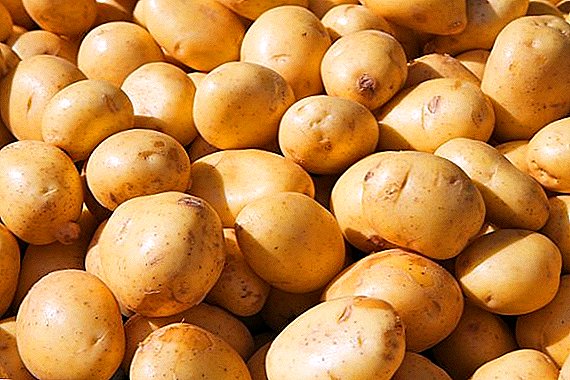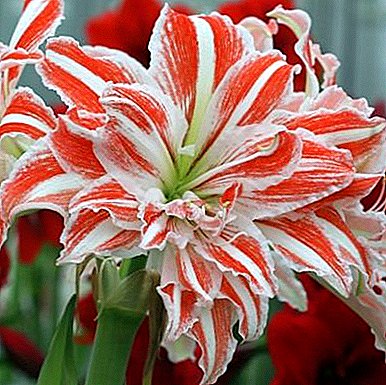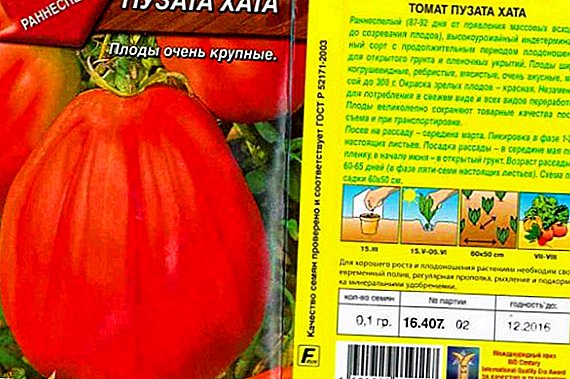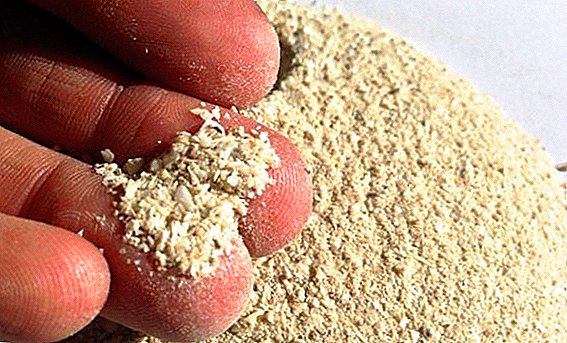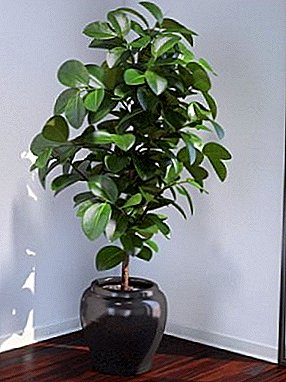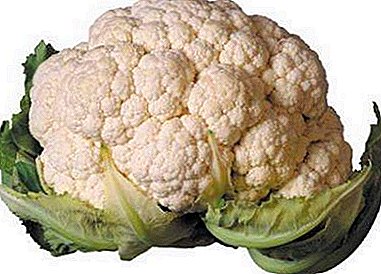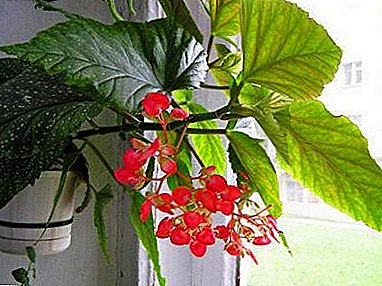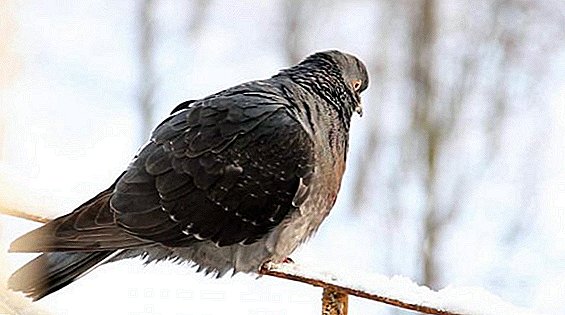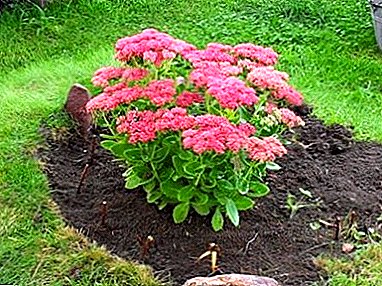
Sight prominent It has the scientific name Hylotelephium spectabile, which in Latin means attractive.
To deny the attractiveness of this plant is really difficult.
BUT almost no need to care for him.
The article below describes the stonecrop (Sedum) prominent, as well as its varieties, care, planting and photo of the plant.
Description
Sight prominent received such a name not without reason. He stands out not only variegated flowers, but tall (from 30 to 50 cm), straight and fleshy shoots.
Do not notice it is really difficult. Oval bluish-green leaves with barely noticeable cloves along the edges are alternately located on the stem.
 Light pink flowers have 5 petals and form false umbrellas. Root thickened and tuberiform.
Light pink flowers have 5 petals and form false umbrellas. Root thickened and tuberiform.
It is easy to confuse this view with the stonecrop ordinary (purple). At the end of the twentieth century, both of them were not in vain identified in a separate genus Ochnitnik, which included another 26 species.
How to distinguish the stonecrop visible from the stonecrop purple? Due to the color of flowers. In the second, it is closer to the white color than in the first.
At the beginning of floweringwhen both species have white flowers, it is impossible to distinguish them from a person without deep knowledge of botany.
Sorta
Motley inflorescences, slender and tall stem quickly attracted the attention of breeders around the world.
First stonecrop varieties prominent were withdrawn in the early twentieth century. The following varieties gained the greatest popularity in gardening:
Diamond

Brilliant It was launched back in 1913. Based on it, breeders have created many modern varieties. Numerous shoots (from 15 to 20) form dense bushes with a height from 30 to 40 cm.
Bloom begins in mid-August and continues until the first frost. Bright pink flowers form corymbose inflorescences up to 15 cm in diameter.
Xenox

Xenox grows dense and tall bush.
The diameter and height reach 50 cm. The leaves are dark purple. The flowers form small red-purple inflorescences.
Diamond edge

Diamond edge has a fairly modest size compared to other varieties. The height of the bush does not exceed 25 cm, and the diameter is 35 cm.
Remarkable color leaves - pinkish green with cream border. Light pink inflorescences - up to 15 cm in diameter.
"Frosti Morne"

Frostymorn (in translation "frosty morning") fully justifies its name.
The flowers are greenish white, and the leaves are pastel green with white trim. The height and diameter of the bush does not exceed 40 cm.
Herhstfreude

Herhstfreude reaches a height of 40-50 cm, has dark green leaves with a waxy bloom and reddish-lilac flowers.
Purple emperor

Purple emperor grows dense bush height of 60 cm and an incredible diameter of 80 cm
Large oval leaves of a purple-red shade are perfectly combined with large pink inflorescences, blooming in late July.
Superior white

Superior White is distinguished by large, dazzling white inflorescences. Bush height - 50 cm.
Postmaces pride

Postmaces pride has burgundy flowers, purple stems and leaves. The height of the shoots reaches 40 cm.
Red cauli

Red cauli grows out weaker than other varieties. The height of the shoots is 40 cm. Oval leaves have a purple-green color, and dark pink flowers are collected in small scutes.
AutumnJoy

AutumnJoy has a height of 50 cm, pastel-green leaves and large dark crimson shields of flowers.
Mediovariegatum

Mediovariegatum grows dense, but low bush (up to 20 cm). Stems are different from other varieties - quite thin and not so slim.
The leaves are green, but with a yellowish middle. Much more capricious than the original look and requires constant pruning of green shoots.
Anyone who wants to grow exactly varieties, it is worth knowing that they are much less hardy than their wild progenitor.
Care
Sedum is very unpretentious in the care. It is ideal for people with a lack of time.
Landing
Sedum planting it is best to make it prominent in the spring when the active growth period begins.
 You can also do it in summer or autumn before the onset of frost. In winter, landing is possible only in room conditions.
You can also do it in summer or autumn before the onset of frost. In winter, landing is possible only in room conditions.
Like all members of its kind, stonecrop prominent enough unpretentious and after buying it, you can not even replant.
However, in order to detect root diseases (if any) in time, transplantation is still recommended.
Priming
Tall stonecrops, including this species, unlike undersized relatives, grow better in fertile soil. Ideal nutrient loam with the addition of a large amount of compost or humus.
Very afraid of Sedum prominent bays.
Priming should provide good circulation of water and air. Plants planted in a pot need a drainage layer.
Weeding is recommended at each inspection. Coexistence with different weeds is possible, but at the same time the growth of stonecrop slows down significantly, and it may not even bloom.
Fertilizers
Can not say that top dressing vital. But if from time to time slightly fertilize it with minerals and organic matter, the results will be more impressive and will appear earlier.
At the same time, overfeeding is too dangerous - everything can result in rotting of the roots and death.
Watering
 Watering stones only in room conditions. Plants planted in the ground, need to be watered only with a clear lack of moisture.
Watering stones only in room conditions. Plants planted in the ground, need to be watered only with a clear lack of moisture.
Too frequent and abundant watering is dangerous, as it easily leads to stagnant water and rotting roots. Most diseases arise precisely because of over-irrigation.
Lack of moisture occurs very rarely, since the sedum accumulates moisture not only in fleshy leaves, but also in numerous underground tubers.
Lighting
Pritenyat it is not necessary even in the midday hours at the height of summer. From time to time it is recommended to wipe the leaves from dust with a slightly damp cloth.
Dust is able to trap significantly the amount of sunlight that is so necessary for this plant.
Thermal mode
 Slick prominently included in the list of the most hardy representatives of a kind.
Slick prominently included in the list of the most hardy representatives of a kind.
Adult bushes feel good at any temperature.
In winter, the aerial part dies off, but in the spring it always grows back.
No preparation for wintering is necessary. There is no need for a winter shelter either.
Transfer
Every 5 years you need to rejuvenate the bush, as it begins to lose its decorative properties.
The plant is divided into 3-4 parts and planted at a distance of 30-40 cm (depending on the variety) from each other. It is best to do this in early spring.
Bloom
Flowering continues from July to September.. If the autumn is dry and there are no severe frosts, it can bloom right up to December and even stand for a short time in this state under the snow. Smell - pleasant, something resembling a rose.
After flowering stalks should be cut, in order not to deprive the plant of the forces needed to prepare the stonecrop visible for winter.
A photo
Sight prominent:


Sedum prominent:


Breeding
Being very hardy, stonecrop prominent breeds in many known ways.
The easiest way - multiplication of stonecrop prominent cuttings, leaves. The optimal time for this method is mid-summer.
Cuttings or leaves after cutting dried in a lightened, but cool place. Then immersed in the ground. If it is a cutting, then it is buried 1 cm in the soil. Young stonecrops sparsely water and shade from the direct sun.
Cuttings can be planted immediately in open ground. This option will be even better, as the plant reacts negatively to frequent transplants.
Transplantation in open ground should be carried out no later than September, so that sudden frosts do not kill the young stonecrop.
 It is worth noting one feature stonecrop prominent. In winter, its aerial part dies off, but it grows again in spring. Therefore, you should not be afraid at the sight of dead shoots.
It is worth noting one feature stonecrop prominent. In winter, its aerial part dies off, but it grows again in spring. Therefore, you should not be afraid at the sight of dead shoots.
Equally effective is bush dividing. Such tall species often propagate by this method.
The adult five-year-old bush is dug out in the fall or spring, and then cut along with the rhizome into 4 parts (there must be at least one tuber in each part). Separated parts are dried in a cool place and then planted in the ground.
Seed propagation does not always give good results, but it is possible. Stonecrop seeds are sown in boxes in early spring or autumn.
Subsequently, they can be dug into the garden to avoid transplanting. In order for the seeds to come up they need heat and diffused sunlight.
After the appearance of 1-2 leaves, youngsters are seated at a distance of 30 cm from each other.
Diseases and pests
Diseases affect the hare cabbage extremely rarely.. If you do not overdo it with watering and fertilizing, everything will be fine with health ...
When a disease is detected stonecrops are dug, the infected parts of the roots are cut, the sections are treated with fungicidal preparations and dried. After this transplant is carried out. Watering is prohibited for a long time.
Of pests affect sedum prominent thrips, aphid, weevil. Insects are removed manually. Damaged leaves are cut, and the rest of the plant is treated with insecticides.
Beneficial features
Sink not knowingly got such popular names as young, zhivuchka and live grass.
 Plant from ancient times used as an antimicrobial and painkiller.
Plant from ancient times used as an antimicrobial and painkiller.
In modern folk medicine, stonecrop prominently used frequently. On its basis, boiled infusions. They are believed to help with heart disease, pulmonary insufficiency, problems with the digestive system (with the exception of gastritis and ulcers).
Surely we can say that infusions of stonecrops tone up the body and relieve fatigue.
But despite all the centuries-old fame of the medicinal properties of stonecrop prominent, self-healing is not worth it. Do not forget that many stonecrop are poisonous.
Anyone can decorate his garden with stonecrop prominently. It is difficult to find a less capricious handsome.


